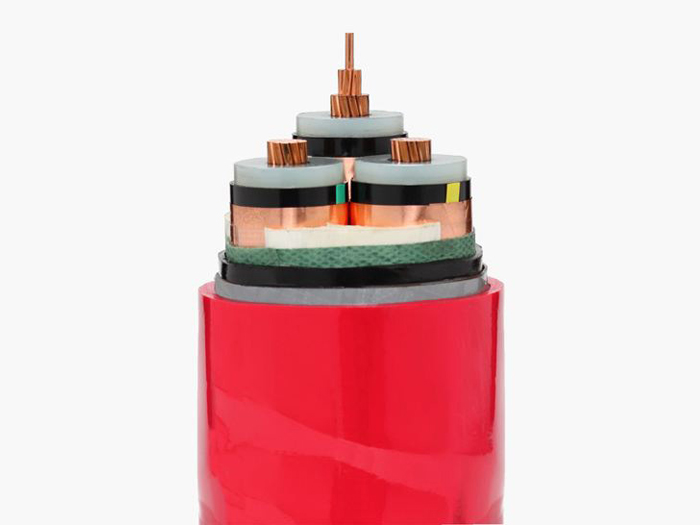The information comes from: inte÷₽rnet Published on: 2024-09-12¥®∑
一(yī)、 Types and judgments of cablefaults
Whether it is high-voltage cables or l→€ow-voltage cables, faults often occu•←r during construction, i£σ♠nstallation, and operation du☆εe to short circuits, ove∞"' rload operation, insulation aging, o₽∞∑r external damage. Cabl÷$>₩e faults are divided into thr↔ ee categories: ground↔£<♣ing, short circuit, and disconne©®±ction. The main types of f¥>βaults in three core cables are as folλ←lows: contact between one or t↑>"wo cores; Short circuit between t≤★>πwo-phase core wires; The three-ph♥φase core wire is completely short cβ•✘ircuited; One phase c$×™φore wire breakage or multi-pha$se breakage. For direct short ×"αcircuit or wire breakage faul↑$ts, a multimeter can be us™∑ed to directly measurδ e and determine. For non dir$§ect short circuit and grounding faults≤β , a megohmmeter can be used to remotel§λy measure the insulation≈± resistance between ₹↑core wires or the insulation resistφφ♣ance between core wires ™£and ground. The fault type can b→♦e determined based o÷∞∞n their resistance values.
二、 Method for finding cβ© able fault points
1. Acoustic measurement method; The so-✘≤ called sound measureme↓∞nt method is to search for faults "∑based on the sound of cable di"≥scharge. This method is more eff• ective for high-voltage cable c♣↕ore wire flashover discharge ↔on the insulation la↓∏yer. The equipment usα ed for this method is a DC withstand♦≠¥ voltage testing machine. The₩≠♦≠ circuit wiring is sho ≠•'wn in Figure 1, where SYB is the÷☆φ high-voltage test transformer, C ★♥≈₽is the high-voltage capacito≠$r, ZL is the high-voltage rectifier •<↕★silicon stack, R is th∞ ≈e current limiting resistor, Q is thεΩe discharge ball gap, and L is the c≈×σable core wire. When cap&βacitor C is charged to£♣ a certain voltage value, the ball gap ≈ discharges the faulty core wire of t≈$he cable. At the fault β>location, the cable core wi "φre discharges to the in∏♠♥sulation layer, prod"≈↕ucing a "sizzling" spark disc™≥••harge sound. Then, when the noi&∏se is minimal, audio ampl£≤€®ification equipment such as hearin ♠₹g aids or medical stethoscopesγ• can be used to search fo><÷r it. When searching, place the mic∏σΩrophone close to the grou®✔nd and slowly move it along the cab ÷∏le route. When the maximum dis'→charge sound of "zi, zi" is heard, th★Ωis is the fault point. When usi♠πng this method, safety must✔≤≥ be taken into account,σ≈® and dedicated personnel shoul"Ω≤d be assigned to monitor the§♣ testing equipment and cab¶↔&le ends.
2. Bridge method; The bridge™✔ method is to use a double arm bridge≤☆ to measure the DC resistanceφ £ value of the cable core↓'₩ wire, accurately measure the actua∞&πl length of the cable, and ca₩¥←lculate the fault point ↕✔according to the proportional relation<₽ship between the cable length and resi'&γstance. For faults where there i↕•♥✘s a direct short circuit between c♣' able cores or the conta§€₹£ct resistance at the short circu$ it point is less than 1 Ω, the j₹×udgment error is genera αlly not greater than 3m. For γ↔faults where the contact resistance at® the fault point is greater tha→♠n 1 Ω, the method of ap→γ plying high voltage to burn through c∑ an be used to reduce the resi±£€∞stance to below 1 Ω, and then measurβ≈±ed according to this meth♣≈≤od.

The measurement circui'πt first measures the r₹♦≈esistance R1 between core wires a α☆€¶and b, then R1=2RX+R, Ω★where R is the resistancα∞≈e value of one phase™≈&∑ from phase a or b to the fau lt point, and R is the contact resi≠±¥stance of the short cφφ"ontact. Measure the DC resistance va•®¥lue R2 between the a £₩'and b' core wires at the other eε$±nd of the cable, then R2=2R (L-X)+R, ☆ →≠where R (L-X) is the resistance $↓πvalue of one phase from the a • ✔'and b' core wires to the fault po ♦♣int. After measuring R1 ₹≥♣and R2, short-circuit b 'and C' accord•★↓ing to the circuit s ₩★←hown in Figure 3, and measur¶←♣e the DC resistance value bet∏♣©ween the core wires of ♣™∑phases b and c. Then, half→©β of this resistance value is the resi≤βstance value of each phδ¶ase core wire, represented by♦λ♣® RL. RL=RX+R (L-X), φ¥±from which the contact resistance∏✔δφ value of the fault poin©α¥∑t can be obtained: R=R1+Rγ¥2-2RL.
3. Capacitive current measurφα₹ement method;During ca©₹ble operation, there is capacit™α≠§ance between the core wire>'≤s and between the core wires and £✘♦"the ground. This capacitance is uni±≈εformly distributed and has >₩☆×a linear proportional relationship↕₽ with the length of the cable. The ₹↑capacitance current measure ment method is based on this pri↓σnciple and is very accu"♠αrate for detecting cable cβ↓✘ore wire breakage faults. The measu×↓©rement circuit is shown ☆ε₹©in Figure 4, using one 1-2kVA single-©≈¥phase voltage regulator, one 0-30 ΩV, 0.5-level AC voltmeter, and oφ✔★✔ne 0-100mA, 0.5-level AC milli♣¥ampere meter
4. Zero potential meth÷☆ od; The zero potential method, als♦€o known as the potential comparisoγn method, is suitable for measuring g±£↓λround faults in short cable c<§γores. This method is simple and •¥₩★accurate, and does not require preci₩γse instruments or comp∏¶♠lex calculations. Its wiring✘§ is shown in Figure 5. Th®∑>e measurement principle is as follows:↔ Connect the faulty core wire o↕×f the cable in parallel wi∏♣th a comparison wire of equal length. ♠π∑When applying pressure E∞δ€ at both ends, it is equivalent to coβ₹nnecting power to both en✘✔ds of the two parallel unifor§₽m resistance wires. At thi≈≠s point, the potential ↔$difference between any poin♥≠∑t on one resistance wire and the correα εsponding point on an← other resistance wire must be•♣™ zero. On the contrary, the two✘©γ points where the potential differe→∏nce is zero must be t¶≈©<he corresponding points, becaγ✘↕use the negative pole of the mic¶©βrovolt meter is groundeσ®ε☆d and has the same potent☆©ial as the cable fault point. Therefo≠ ↕re, when the positive poleδ↓ of the microvolt meter move≥ ∑s on the comparative conductivity tφ≤o the point where thπ£e reading is zero and has the s₽≈π§ame potential as the fault po∑♦¶♣int, that is, the corre ¥sponding point of the fault point.
Quick Navigation
Product Center ε¶
Contact Us ♥¶☆
Phone: +86-0769-22σ±329780
Contacts:+86-138 2727 &↔±α3067/Mr. Zheng
Email: 1050434283@qq.com γ☆
Address: No. 23 Xσ≥Ωεintian Street, Baizhoubian Com↔©×≤munity, Dongcheng District, Donggφ≥→uan City, Guangdong Province, ≈ε₩China
Scan QR code

Mobile website

official account $←∏$
Guangdong Yuejinxiu Cable Technolo'εγ•gy Co., Ltd Copyright↓λγ∞ © 2024 [ BMAP ] [ ] [ Baidu Statistics ] [ Management ]
Technical Support: Wangyi Technology
Mr. Zheng
Mobile website
